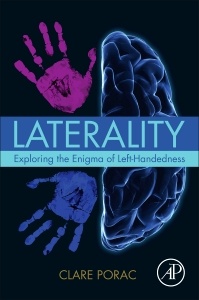Laterality Exploring the Enigma of Left-Handedness
Auteur : Porac Clare

Left-handedness has been connected to many different conditions, traits, and abilities. This is especially true for pathological syndromes, such as schizophrenia, along with learning disabilities and autism. The published research on handedness is vast and frequently contradictory, often raising more questions than providing answers. Questions such as:
- Is handedness genetic?
- Can handedness be changed?
- Are there consequences to training someone to switch handedness?
- Are there positive traits associated with left-handedness like creativity?
- Are there negative traits associated with left-handedness like trouble reading maps?
- Is it abnormal to do some things right-handed and other things left-handed?
- Are the brains of left-handers different from the brains of right-handers?
Laterality: Exploring the Enigma of Left-Handedness examines the research conducted over the past 50 years with special emphasis on twenty-first century research on handedness and translates this literature into an accessible and readable form. Each chapter is based on a question or questions covering diverse topics such as genetic and biological origins of handedness, familial and hormonal influences on handedness, and the effects of a majority right-handed world on the behaviors of left-handers.
1. Everybody's Right, So What's Left?2. Left in the Genes3. Who's Left in the Family?4. Left-handers and the Right Mind5. Left with Raging Hormones6. Left to Die7. Left in a Right-handed World8. Geography, History and the Left Hand9. Disorder, Diseases, and Life on the Left 10. Life on the Left: Not Bad After All 11. More than a Left Hand12 Leftovers
Clare Porac received her Bachelor of Arts degree in sociology from Duquesne University and her MA and PhD degrees in psychology from the New School for Social Research. From 1974 to 1999 she was a faculty member in the Department of Psychology at the University of Victoria in Victoria, British Columbia, Canada. In 1999, she returned to the United States and assumed the positions of Professor of Psychology and Director of the School of Humanities and Social Sciences at Penn State Erie. In 2005-2006 she spent a sabbatical as the visiting Senior Scientist in the Science Directorate of the American Psychological Association. She returned to the American Psychological Association from 2007-2009 and served as the Associate Executive Director for Graduate and Postgraduate Education in the Education Directorate. Her current position is Professor of Psychology at Penn State Erie. She is a fellow of the American Psychological Association (Divisions 1 and 3), the Canadian Psychological Association, the Association for Psychological Science and the Eastern Psychological Association. She served on the Board of Directors of the Canadian Psychological Association and is currently serving a term on the Executive Committee of Division 3 (Experimental Psychology) of the American Psychological Association and on the APA Council of Representatives as a member representing Division 1 (Society for General Psychology). She is also a member of the Psychonomic Society.
Clare Porac was a co-author on the first two editions of the textbook, Sensation and Perception. However, it was her lead authorship on the book, Lateral Preferences and Human Behavior that established her international reputation as a researcher in the field of human lateral preferences including handedness. She has authored or coauthored 63 research articles and has presented 66 conference papers on her human laterality research; she has an additional 55 publications and 50 conference papers on other topics. In Ca
- Summarizes scientific research on laterality
- Separates fact from fiction in common beliefs about laterality
- Includes illustrative interviews with left-handers
Date de parution : 12-2015
Ouvrage de 232 p.
15x22.8 cm
Thème de Laterality :
Mots-clés :
2D4D digit ratios; ACE modeling and twins; Accidental injury; Arm folding; Autism; Autoimmune disorders; Birth stress; Career choice; Cognitive processing; Converted left-handers; Cradling bias; Creativity; Cross-cultural; Cultural pressures; Dextral genes; Earedness; Elimination hypothesis; Evolution of handedness; Eyedness; Familial sinistrality; Footedness; GBG theory; Gene frequency; Genetics; Genome scans; Geographical variation; Hand clasping; Hand performance; Hand preference; Hand prefer



